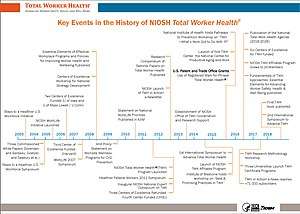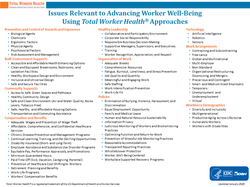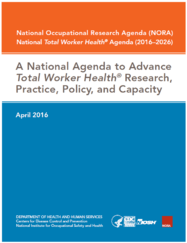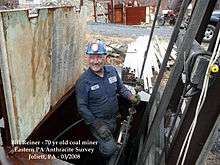Total Worker Health
Total Worker Health is a trademarked strategy defined as policies, programs, and practices that integrate protection from work-related safety and health hazards with promotion of injury and illness prevention efforts to advance worker well-being. It was conceived and is funded by the National Institute for Occupational Safety and Health (NIOSH). Total Worker Health is tested and developed in six Centers of Excellence for Total Worker Health in the United States.[1]
Definition
Total Worker Health is defined as policies, programs, and practices that integrate protection from work-related safety and health hazards with promotion of injury and illness prevention efforts to advance worker well-being.[1][2]
Traditional occupational safety and health protection programs have primarily focused on ensuring that work is safe and that workers are protected from the harms that arise from work itself.[1] Total Worker Health (TWH) builds on this approach through the recognition that work is a social determinant of health.[3] Job-related factors such as wages, hours of work, workload and stress levels, interactions with coworkers, and access to leave and healthful workplaces all can have an important impact on the well-being of workers, their families, and their communities. TWH explores opportunities to not only protect workers, but also advance their health and well-being by targeting the conditions of work. Scientific evidence now supports what many safety and health professionals, as well as workers themselves, have long suspected—that risk factors in the workplace can contribute to health problems previously considered unrelated to work. For example, there are work-related risk factors for abnormal weight fluctuations,[4][5] sleep disorders,[6] cardiovascular disease,[7] depression,[8][9][10] and other health conditions. In recognition of these emerging relationships, the TWH approach focuses on how environmental, workplace factors can both mitigate and enhance overall worker health beyond traditional occupational safety and health concerns.[1]
History
Total Worker Health originated from the Steps to a Healthier US Workforce symposium in October 2004, which sought to bring together knowledge and experience of health protection and health promotion, in order to stimulate action for the development of programs.[11] The symposium developed around themes of research, practice and policy related to the integration of health protection and health promotion.[11]

By 2005, the initiative was redeveloped from the Steps to a Healthier US Workforce Symposium and renamed the NIOSH WorkLife Initiative.[11] The WorkLife Initiative supported addressing worker health and well-being in a novel way, by addressing the physical and organizational work environment concurrently with personal health decisions and behaviors of individuals.[11] Some aims of the WorkLife Initiative included supporting evaluation of integrative approaches to work and health, promoting adoption of proven policies and practices, motivating trans-disciplinary collaboration among investigators and overcoming the traditional separation of occupational health and health promotion among professional communities.[11] In September 2007, NIOSH and 35 other sponsors conducted the "WorkLife 2007: Protecting and Promoting Worker Health" symposium, in which over 450 participants explored the science and economics of integrated work-based programs, policies and practices that sustain and improve worker health and well-being.[11] Collaborators at the symposium, which included leaders from labor, business and academic communities provided evidence of work and health benefits from integrated approaches.[11] Coupled with case studies and anecdotal reports, the overall consensus was that such integrated work-based programs, if executed and sustained properly, can be good for worker health and business.[11]
In 2008, collaborators at NIOSH and the Centers of Excellence developed 10 recommendations, grouped in practice, research and policy, as a long-range strategy for advancing the WorkLife Initiative.[12] These recommendations were based on evidence-based practice and research-to-practice initiatives.[12] In 2011, a collaborative symposium with other federal agencies culminated in the "Healthier Federal Workers 2011 Symposium", which applied the integrated work health approaches to federal employees.[11]
In 2011, NIOSH WorkLife became "Total Worker Health" to better convey the more comprehensive approach to workplace prevention.[13] With Total Worker Health, NIOSH can continue to develop the initiatives from the WorkLife Initiative through research, interventions, partnerships and capacity building to meet the needs of the 21st-century workforce.[13] The 10th International Conference on Occupational Stress and Health, known as Work, Stress and Health 2013: Protecting and Promoting Total Worker Health was organized by NIOSH along with the American Psychological Association and the Society for Occupational Health Psychology.[14]
Proposed provisions to the Affordable Care Act for 2014 onwards, made by President Obama's administration, include a rule allowing employers to increase incentives awarded to employees participating in workplace well-being programs.[15][16] Specifically, employers will be able to increase incentives from the currently allowable 20% to as much as 30% of an employee's insurance costs, and up to 50% in some cases.[15] This provision applies to employees working towards achieving an agreed-upon well-being goal.
The year 2012 marked the publication of The Research Compendium: The NIOSH Total Worker Health Program: Seminal Research Papers 2012[17] presenting the rationale for the TWH approach. These papers noted that a small, but growing body of evidence suggests that integrating occupational safety and health protection program activities with other workplace policies, programs, and practices is more effective for safeguarding worker safety, health, and well-being than either of these programmatic activities on their own.
In 2014, NIOSH created the Office for TWH Coordination and Research Support (Office for TWH) to coordinate and advance these extramural and intramural efforts. In that same year, the Office for TWH partnered with the Institute of Medicine to host a workshop on “Best and Promising Practices in Total Worker Health”, and also coordinated the 1st International Symposium to Advance Total Worker Health in Bethesda, MD, drawing over 350 live attendees.
The year 2015 marked developments for the program and Office, including the U.S. Patent and Trademark Office’s granting of the mark “Total Worker Health” as an official registered trademark of the U.S. Department of Health and Human Services; the launch of the first Center within TWH, the National Center for Productive Aging and Work; and a NIH-cohosted Pathways to Prevention Workshop[18] titled: “Total Worker Health®—What’s Work Got to Do with It?”.
In 2016, the NIOSH Office for Total Worker Health released a National Occupational Research Agenda (NORA) National Total Worker Health Agenda[19] to define and prioritize occupational safety and health research, practice, and prevention activities for 2016-2026 and published Fundamentals of Total Worker Health® Approaches: Essential Elements for Advancing Worker Safety, Health, and Well-being[20]. That same year, NIOSH funded six Centers of Excellence to conduct research on the concepts of Total Worker Health.[21]
In 2017, three universities launched certificate programs for TWH.[22] The TWH in Action! e-Newsletter also reached over 71,000 subscribers, providing quarterly updates on Total Worker Health strategies and from the Centers of Excellence for TWH, and the TWH Research Methodology Workshop was held.
In 2018, the National Institute for Occupational Safety and Health hosted the 2nd International Symposium to Advance Total Worker Health May 8-11 in Bethesda, MD on the historic campus of the National Institutes of Health, just minutes from Washington, DC. The 2018 theme was Work & Well-Being: How Safer, Healthier Work can Enhance Well-Being.[23]
The year 2019 marked the first TWH publication, Edited Volume on Total Worker Health.[24]
Issues

The accompanying graphic, “Issues Relevant to Advancing Worker Well-Being Using Total Worker Health® Approaches” illustrates a wide-ranging list of issues that are relevant to advancing worker safety, health, and well-being. Revised in January 2020, this list reflects an expanded focus for TWH that recognizes workplace and work issues such as innovative technologies, working conditions, and emerging forms of employment that present new risks for today’s and tomorrow’s workforce. Additionally, this expanded focus recognizes that there are linkages between health conditions that may not arise from work but that can be adversely affected by work. Understanding, preventing, and reducing these risks are important elements of TWH. A TWH approach advocates for the integration of all organizational policies, programs, and practices that contribute to worker safety, health and well-being, including those relevant to the prevention and control of hazards and exposures, built environment supports, community supports, compensation and benefits, healthy leadership, organization of work, policies, technology, work arrangements, and workforce demographics.
Centers of Excellence for Total Worker Health
NIOSH has funded six Centers of Excellence for Total Worker Health in the United States to explore and research concepts of TWH.[21] Some tasks of the Centers of Excellence include:[21]
- Pilot testing promising workplace policies and programs
- Developing and disseminating best practices and tool kits
- Developing strategies for overcoming barriers to organizational acceptance and adoption of comprehensive, coordinated work-based safety, health, and well-being policies, programs, and practices
- Investigating costs and benefits associated with integrated programs
- Promoting increased development and application of physiological and biological markers of stress, sleep, and depression and their use for worker protection or improved health outcomes
The six Centers of Excellence are based in seven separate universities in the United States. Locations of said Centers are as follows:
- Center for Health, Work & Environment - University of Colorado School of Public Health - Aurora, Colorado
- Center for the Promotion of Health in the New England Workplace - University of Massachusetts Lowell and University of Connecticut at Farmington and Storrs.
- Harvard T.H. Chan School of Public Health Center for Work, Health and Well-being - Harvard-T.H. Chan School of Public Health - Boston, Massachusetts
- Healthier Workforce Center of the Midwest - The University of Iowa - Iowa City, Iowa
- Oregon Healthy WorkForce Center - Oregon Institute of Occupational Health Sciences, Oregon Health & Science University - Portland, Oregon
- University of Illinois-Chicago Center for Healthy Work - University of Illinois-Chicago - Chicago, Illinois
NIOSH Total Worker Health Affiliate Program
The mission of the NIOSH Total Worker Health Affiliate Program[25] is to foster an integrated approach to protecting and promoting worker well-being through collaborations with academic, labor, nonprofit, and government organizations.
The TWH Affiliate Program seeks to:
- Increase the visibility, uptake, and impact of Total Worker Health (TWH) to advance the safety, health and well-being of workers through NIOSH assistance to Affiliates.
- Attract and assist new collaborators to enrich and broaden current NIOSH TWH translational research.
- Attract and work with new collaborators to enrich and broaden current NIOSH TWH practice and dissemination efforts.
- Publicly recognize the contributions of the Affiliates to the development and dissemination of TWH research and practice.
The current NIOSH TWH Affiliates are listed on the TWH Affiliates webpage.
Fundamentals of Total Worker Health Approaches: Essential Elements for Advancing Worker Safety, Health, & Well-Being (2016)

The workbook, Fundamentals of Total Worker Health® Approaches: Essential Elements for Advancing Worker Safety, Health, and Well-being,[20] prioritizes a hazard-free work environment for all workers and applies a modern prevention approach—consistent with traditional occupational safety and health prevention principles—that recognizes that job-related factors can have an important impact on the well-being of workers, their families, and their communities.[26] Fundamentals of Total Worker Health Approaches: Essential Elements for Advancing Worker Safety, Health, and Well-Being builds upon the work of experts in the previous publication, Essential Elements of Effective Workplace Programs, with more recent research, resources, and recommendations that reflect the evolution and progression of TWH itself as a concept. The Fundamentals of TWH Approaches workbook focuses on five Defining Elements of TWH:
- Defining Element of TWH 1: Demonstrate leadership commitment to worker safety and health at all levels of the organization.
- Defining Element of TWH 2: Design work to eliminate or reduce safety and health hazards and promote worker well-being.
- Defining Element of TWH 3: Promote and support worker engagement throughout program design and implementation.
- Defining Element of TWH 4: Ensure confidentiality and privacy of workers.
- Defining Element of TWH 5: Integrate relevant systems to advance worker well-being.
Essential Elements of Effective Workplace Programs (2008)
The Essential Elements of Effective Workplace Programs and Policies for Improving Worker Health and Wellbeing was first published in 2008. This document has since been updated and expanded in the recently published Fundamentals of Total Worker Health Approaches: Essential Elements for Advancing Worker Safety, Health and Well-being. The resources contained in the original Essential Elements are provided here for historical reference.
From the collaborations with the WorkLife Initiative, the Essential Elements of Effective Workplace Programs and Policies for Improving Worker Health and Wellbeing were developed detailing 20 key components of a comprehensive work-based health protection and health promotion program.[27] These components were grouped into one of four areas: Organizational Culture and Leadership; Program Design; Program Implementation and Resources; and Program Evaluation.[27] The essential elements of effective workplace programs are as follows:
| Organizational Culture and Leadership | Program Design | Program Implementation & Resources | Program Evaluation |
|---|---|---|---|
| Develop a "human centered" culture | Establish clear principles | Be willing to start small and scale up | Measure and analyze |
| Demonstrate leadership | Integrate relevant systems | Provide adequate resources | Learn from experience |
| Engage mid-level management | Eliminate recognized occupational hazards | Communicate strategically | |
| Be consistent | Build accountability into program implementation | ||
| Promote employee participation | |||
| Tailor programs to the specific workplace | |||
| Consider incentives and rewards | |||
| Find and use the right tools | |||
| Adjust the program as needed | |||
| Make sure the program lasts | |||
| Ensure confidentiality |
Research
National Total Worker Health Agenda and NIOSH Response to Summarized Stakeholders' Comments

In 2016, the NIOSH Office for Total Worker Health released a National Occupational Research Agenda (NORA) National Total Worker Health Agenda[19] (Agenda) to define and prioritize occupational safety and health research, practice, and prevention activities for 2016-2026. The Agenda, representing the first time a TWH-specific NORA has been created, builds on an earlier draft (Proposed National TWH Agenda) released by NIOSH’s Office for Total Worker Health in September 2014. NIOSH invited stakeholders to provide comment on this draft agenda related to the top priority research, practice, and policy issues to help advance worker safety, health, and well-being. In 2015, in response to stakeholder input received, the TWH definition was expanded and the TWH approach was more finely focused in the final Agenda. The refined description now present in the published Agenda better reflects the priorities of the program and helps to overcome the equating of TWH with traditional workplace wellness programs that fail to integrate worker protection elements. TWH continues to place priority upon a hazard-free work environment that protects the safety and health of all workers. The National Total Worker Health Agenda and NIOSH Response to Summarized Stakeholders’ Comments[28] can be found online.
Sit-stand workstations

Concerns over the increasingly sedentary lifestyle of individuals and the associated health risks lead to this development. A study from a large sample of Australian adults found that prolonged sitting was a risk factor for all-cause mortality, independent of physical activity.[29] Sit-stand workstations are custom-built computer workstations, allowing the user to adjust the height of the workplace envelope and to work while standing. With the implementation of sit-stand workstations, individuals will be able to reduce sedentary time while at work, thereby improving health outcomes, and possibly improving work productivity.
Published research in 2012 on the benefits from implementing sit-stand workstations in the workplace has resulted in the development of some pilot studies for Total Worker Health. While the individual results of the studies varied, the researchers found that sit-stand workstations resulted in an overall improvement in health outcomes of workers who switched to these workstations, in addition to the reduced sitting time. Such health benefits from these pilot studies include increased HDL cholesterol, improved mood outcomes, reduced eye strain, and reduced upper back, neck and shoulder pain.[30][31][32] Robertson et al. found that the sit-stand workstation users, who were trained to vary their postures at work, exhibited increased productivity at work, compared to those who were not trained so.[32] Further, the study by Pronk et al. showed decreased fatigue and increased vigor among participants.[31] With these findings, NIOSH has begun a pilot program among employees for the Total Worker Health initiative.[33]
Health care workers
Several studies out of the Harvard Center for Work, Health and Wellbeing have focused on the relationships between work context and quality of life measures for health care workers. A survey of over 1500 hospital patient care workers examined the relationships between health outcomes (lower back pain, inadequate physical activity, and sleep deprivation) and work context measures.[34] Inadequate physical activity and sleep deficiency were associated, while lower back pain was not significantly related to either stressor.[34] Work context measures, such as low supervisor support, harassment at work, job title, and job culture were found to be associated with the quality of life and health outcomes for the hospital care workers.[34]
Aging workforce

Aging in the American workforce, the rapidly increasing numbers of older workers (ages 55 and above) comprising the workforce in the United States, could have significant impacts to the economy, social security benefits, occupational safety and health, health care, and American society as a whole. Researchers from the American College of Occupational and Environmental Medicine (ACOEM) and NIOSH convened a national Invitational Summit on ‘’Advancing Workplace Health Protection and Promotion in the Context of an Aging Workforce’’ to address several questions and to develop consensus statements and recommendations for a national approach to tackle these issues.[35] These issues included why employers should care about aging in the workplace, how to establish best practices to maximize health and productivity of aging workers, how organizational structures can better approach aging in the workplace, what are the barriers to integrating health protection and promotion programs for aging workers, and what tools, programs, and resources exist to overcome the barriers.[35] Some of the consensus statements conceived during this summit include creating a “culture of health” throughout the workplace, creating “age-friendly” programs and policies, increasing the use of incentives to impact change, integrating workforce health as a standard business measures, conducting new research and models to analyze data, and creating a new culture of “shared accountability.”[35]
Organizations with Successful Integrated Health, Safety and Productivity Management Programs
Various companies have implemented integrated health protection and health promotion management programs successfully, with documented health improvements and cost savings.[36] Each integrated program varies a bit in focus areas and in implementation, but follow the components of Total Worker Health. Examples of companies that have yielded successful results from their programs include Caterpillar, FedEx, Dow Chemical and Perdue Farms.[36]
International Symposium to Advance Total Worker Health

The 1st International Symposium to Advance Total Worker Health was first held October 6–8, 2014 at the National Institutes of Health Natcher Center located in Bethesda, Maryland. The 2nd International Symposium to Advance Total Worker Health was held May 8–11, 2018 at the NIH Natcher Center.[37]
See also
References
- "Total Worker Health: Frequently Asked Questions". Centers for Disease Control. Retrieved 2017-01-31.

- "CDC - NIOSH Total Worker Health". www.cdc.gov. Retrieved 2017-01-30.
- "WHO | What are social determinants of health?". www.who.int. Retrieved 2017-01-30.
- Luckhaupt, Sara E.; Cohen, Martha A.; Li, Jia; Calvert, Geoffrey M. (2014-03-01). "Prevalence of Obesity Among U.S. Workers and Associations with Occupational Factors" (PDF). American Journal of Preventive Medicine. 46 (3): 237–248. doi:10.1016/j.amepre.2013.11.002. PMID 24512862.
- "NIOSHTIC-2 Search Results - Full View". www2a.cdc.gov. Retrieved 2017-01-30.
- "NIOSHTIC-2 Search Results - Full View". www2a.cdc.gov. Retrieved 2017-01-30.
- "NIOSHTIC-2 Search Results - Full View". www2a.cdc.gov. Retrieved 2017-01-30.
- "NIOSHTIC-2 Search Results - Full View". www2a.cdc.gov. Retrieved 2017-01-30.
- "NIOSHTIC-2 Search Results - Full View". www2a.cdc.gov. Retrieved 2017-01-30.
- "NIOSHTIC-2 Search Results - Full View". www2a.cdc.gov. Retrieved 2017-01-30.
- "CDC - Total Worker Health History of Total Worker Health - NIOSH Workplace Safety and Health Program". NIOSH. Retrieved 23 October 2012.
- Cherniack, Martin; Henning, Rob; Merchant, James A.; Punnett, Laura; Sorensen, Laura R.; Wagner, Gregory (2011). "Statement on National WorkLife Priorities". American Journal of Industrial Medicine. 54 (1): 10–20. doi:10.1002/ajim.20900. PMC 5860803. PMID 20949545.
- "CDC - Total Worker Health WorkLife Transitions to Total Worker Health - NIOSH Workplace Safety and Health Program". NIOSH. Retrieved 23 October 2012.
- "Work, Stress and Health 2013". American Psychological Association. Retrieved 9 January 2013.
- "CDC - NIOSH - Total Worker Health in Action - January 2013". NIOSH. Retrieved 31 January 2013.
- "Obama administration moves forward to implement health care law, ban discrimination against people with pre-existing conditions". HHS. Retrieved 31 January 2013.
- "CDC - NIOSH Publications and Products - The Research Compendium: The NIOSH Total Worker Health Program: Seminal Research Papers 2012 (2012-146)". www.cdc.gov. 2012. doi:10.26616/NIOSHPUB2012146. Retrieved 2017-01-30.
- Bradley, Cathy J.; Grossman, David C.; Hubbard, Rebecca A.; Ortega, Alexander N.; Curry, Susan J. (2016-08-16). "Integrated Interventions for Improving Total Worker Health: A Panel Report From the National Institutes of Health Pathways to Prevention Workshop: Total Worker Health—What's Work Got to Do With It?". Annals of Internal Medicine. 165 (4): 279–83. doi:10.7326/m16-0740. ISSN 0003-4819. PMID 27240228.
- "CDC - Research Program Development & Collaboration - NIOSH Office for Total Worker Health". www.cdc.gov. Retrieved 2017-02-01.
- "Fundamentals of TWH Approaches Workbook PDF" (PDF). NIOSH.
- "CDC - Total Worker Health WorkLife Centers of Excellence - NIOSH Workplace Safety and Health Program". NIOSH. Retrieved 11 October 2012.
- "Graduate Training, Certification Programs & Degree Programs | NIOSH | CDC". www.cdc.gov. 2019-10-25. Retrieved 2019-12-11.
- "A Total Worker Health Symposium". Retrieved 2019-12-11.
- "Edited Volume on Total Worker Health". www.cdc.gov. 2019-09-17. Retrieved 2019-12-11.
- "CDC - Total Worker Health Topics - NIOSH Total Worker Health". www.cdc.gov. Retrieved 2017-02-01.
- "NIOSH Publication Page for Fundamentals of TWH Approaches". NIOSH. 2016. doi:10.26616/NIOSHPUB2017112.

- "CDC - Total Worker Health Essential Elements of Effective Workplace Programs - NIOSH Workplace Safety and Health Program". NIOSH. Retrieved 23 October 2012.
- "NIOSH Response to Summarized Stakeholders' Comments on Proposed National Total Worker Health Agenda" (PDF).
- van der Ploeg, HP; Chey, T; Korda, RJ; Banks, E; Bauman, A (2012). "Sitting time and all-cause mortality in 222497 Australian adults". Arch Intern Med. 172 (6): 494–500. doi:10.1001/archinternmed.2011.2174. PMID 22450936.
- Alkhajah, TA; Reeves, MM; Eakin, EG; Winkler, EA; Owen, N; Healy, GN (2012). "Sit-stand workstations: a pilot intervention to reduce office sitting time" (PDF). Am J Prev Med. 43 (3): 298–303. doi:10.1016/j.amepre.2012.05.027. PMID 22898123.
- Pronk, NP; Katz, AS; Lowry, M; Payfer, JR (2012). "Reducing occupational sitting time and improving worker health: The Take-a-Stand Project, 2011". Prev Chronic Dis. 9 (110323): E154. doi:10.5888/pcd9.110323. PMC 3477898. PMID 23057991.
- Robertson, MM; Ciriello, VM; Garabet, AM (2012). "Office ergonomics training and a sit-stand workstation: effects on musculoskeletal and visual symptoms and performance of office workers". Appl Ergon. 44 (1): 73–85. doi:10.1016/j.apergo.2012.05.001. PMID 22727324.
- "CDC - NIOSH Science Blog - NIOSH Takes a Stand". NIOSH. Retrieved 11 December 2012.
- Sorensen, G; Stoddard, AM; Stoffel, S; Buxton, O; Sembajwe, G; Hashimoto, D; Dennerlein, JT; Hopcia, K (2011). "The Role of the Work Context in Multiple Wellness Outcomes for Hospital Patient Care Workers". Journal of Occupational and Environmental Medicine. 53 (8): 899–910. doi:10.1097/JOM.0b013e318226a74a. PMC 3693572. PMID 21775897.
- Loeppke, Ronald R.; Schill, Anita L.; Chosewood, L. Casey; Grosch, James W.; Allweiss, Pamela; Burton, Wayne T.; Barnes-Farrell, Janet L.; Goetzel, Ron Z.; Heinen, LuAnn; Hudson, T. Warner; Hymel, Pamela; Merchant, James; Edington, Dee W.; Konicki, Doris L.; Larson, Paul W. (2013). "Advancing Workplace Health Protection and Promotion for an Aging Workforce". Journal of Occupational and Environmental Medicine. 55 (5): 500–506. doi:10.1097/jom.0b013e31829613a4. PMID 23657074.
- Goetzel, Ron Z. (2005). "Examining the Value of Integrating Occupational Health and Safety and Health Promotion Programs in the Workplace" (PDF). NIOSH Report. Retrieved 23 October 2012.
- "TWH Symposium on NIOSH TWH Website". September 14, 2017. Retrieved September 14, 2017.